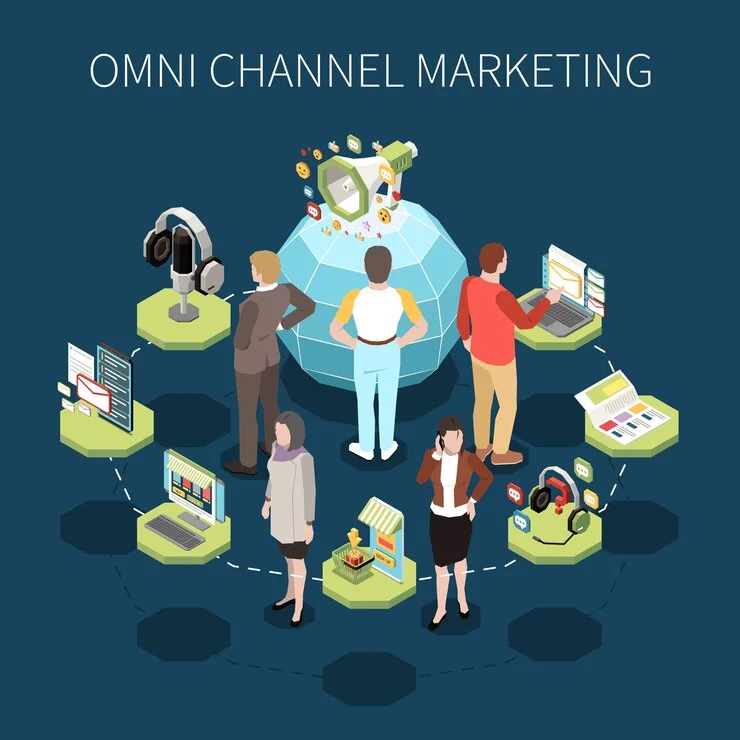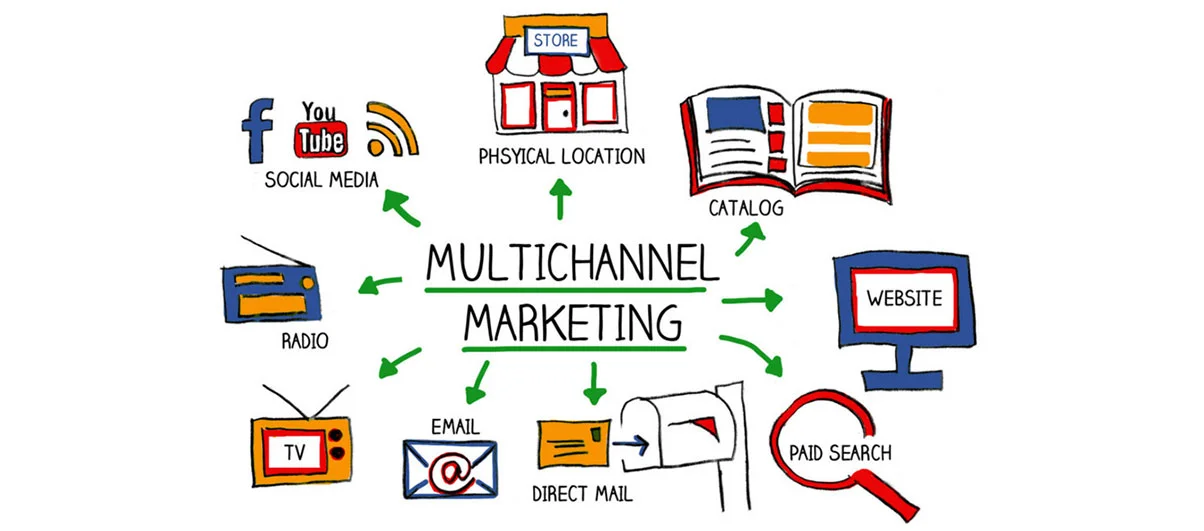TL;DR: Omnichannel vs Multichannel Marketing
Multichannel marketing uses multiple channels like email, social media, and websites, but each works independently. In contrast, omnichannel marketing integrates all these channels to deliver a seamless, personalized customer experience across touchpoints.
In ecommerce omnichannel strategies, brands unify the customer journey across apps, mobile, and stores—driving higher customer engagement, loyalty, and repeat purchases.
Not sure which approach to choose? Use multichannel marketing for quick reach and awareness, but adopt omnichannel marketing if you want an integrated, customer-centric strategy that boosts long-term retention.
The omnichannel vs. multichannel debate has left many businesses wondering which approach better supports their customer engagement goals. While both strategies involve reaching audiences across multiple platforms, the key difference lies in execution. Multichannel marketing uses various platforms—like email, SMS, and social media—independently, with each channel operating in isolation. In contrast, omnichannel marketing seamlessly integrates these channels to deliver a unified, consistent customer experience.
While the difference between the approaches may seem subtle, it can significantly impact how your business connects with its customers. As your product or service gains popularity, the need for a more personalized and seamless experience becomes increasingly vital.
This article will dive into the nuances of omnichannel vs multichannel marketing, helping you understand each approach and craft an engaging customer journey. Let’s explore how these strategies can shape your customer experience and drive meaningful engagement.
What is Omnichannel Marketing?

Omnichannel marketing is a customer-centric approach to creating a smooth, connected experience for customers, regardless of where they interact with your brand.
It is focused on providing a seamless experience, regardless of the path customers choose to take. They enjoy autonomy in deciding how they interact with the brand. For the brand, it’s about delivering a consistent marketing message irrespective of the channel.
Whether on social media or in the brick-and-mortar store, the brand tone and messaging remain consistent, alongside a memorable personalized touch. The personalization can include product app nudges, emails, SMS, and WhatsApp reminders, etc., based on behavioral insights. This personalized touch is not just a marketing strategy but a way to make customers feel appreciated and important.
The strategy is designed based on the customer behavioral data collected from the different touchpoints, enabling contextual and relevant re-targeting. When every interaction with your brand is positive and consistent, customers feel valued and are more likely to stick around.
“Winning in an omnichannel world demands excelling in all channels, from in-person to hybrid, inside sales, digital self-serve, and marketplaces—especially during uncertain economic times in which a poor customer experience may lead to a lost sale.”- The multiplier effect: How B2B winners grow, McKinsey.
Example:
A customer looking to buy a laptop interacts with the brand’s website but abandons his choice in the cart. Soon, he receives a reminder message from the brand of his purchase plan through an email, or an SMS on his registered mobile number. This message is meant to encourage him to visit the physical store for an exclusive discount and get a feel of the laptop.
While visiting the store, he uses the app to locate the item. The in-store staff, aware of the customer’s online activity, offers tailored recommendations, creating a seamless shopping experience.
To truly understand the difference, it helps to look at some omnichannel marketing examples in retail and ecommerce, where brands are moving from multichannel to omnichannel retail experiences.
What is Multichannel Marketing?

As the name suggests, multichannel marketing is a product-centric strategy that uses multiple channels to broadcast brand messaging. These channels work in isolation, intending to meet customers where they are and increase the brand’s reach.
Multichannel marketing can mix traditional media such as TV, radio, print advertisements, and billboards with digital marketing such as online advertisements, social media, pay-per-click, search engine optimization, and so on. In this case, the messaging depends on the employed channels, and they don’t connect with one another.
Example:
A customer views the catalog of the new products in a magazine. They also view ads for the same products in newspapers, social media, and television. They further notice a promotional banner for these products on their website, and soon after, receive an email with a discount for these products. In this case, each channel operates independently, without integrating customer experience across these channels.
Difference Between Omnichannel and Multichannel Explained
While omnichannel views all channels as an integrated entity, multichannel views the channels independently, working towards a common goal. While both focus on driving sales, they differ in terms of customer experience. We have given a detailed difference between omnichannel and multichannel.
| Aspect | Omnichannel Marketing | Multichannel Marketing |
|---|---|---|
| Goal | Provide a unified experience across all channels to improve customer engagement and retention. | Improve brand awareness and recall using multiple channels, highlighting product/service capabilities. |
| Business Focus | Customer-centric, emphasizing personalization and loyalty. | Product-centric, focused on promoting offerings per channel. |
| Customer Experience | Seamless, personalized, and connected across touchpoints. | Fragmented, each channel offers an independent experience. |
| Channel Integration | Highly integrated — data and interactions shared across channels. | Minimal or no integration — channels operate independently. |
| Features | Centralized customer data, real-time personalization, cross-channel workflows, AI-driven automation. | Presence on multiple platforms, channel-specific campaigns, broader reach with less integration. |
| Benefits | Higher retention, stronger relationships, improved CLV, better insights from unified data. | Lower investment, faster to implement, effective for quick visibility and awareness. |
| Challenges | Costly setup, advanced tech and skills required, complex data integration. | Inconsistent messaging, limited personalization, harder to drive long-term loyalty. |
| Investment | High — advanced tools, tech stack, analytics. | Budget-friendly — suitable for startups and SMBs. |
| Messaging | Tailored for each customer based on behavior and preferences. | Tailored for each channel, not individualized. |
| Suitability For | Mid-large enterprises seeking personalization, loyalty, and sustainable growth. | Startups and SMBs focused on reach and visibility. |
The real difference emerges in the omnichannel customer journey. While multichannel ensures presence, omnichannel focuses on delivering a consistent omnichannel experience across all touchpoints
Multichannel vs. Omnichannel Examples: Real-World Use Cases
Let’s break down how top global and regional brands are driving business impact using omnichannel strategies that go far beyond traditional multichannel tactics.
Nike
Nike has mastered omnichannel retail by connecting digital and physical experiences through its app, website, and stores. Customers can:
- Reserve shoes online and try them in-store.
- Use the Nike app for member-exclusive products and fitness content.
- Get personalized product recommendations based on app behavior and past purchases.
Result: A seamlessly connected brand experience that boosts customer loyalty, app engagement, and in-store footfall.
Walmart
Walmart bridges the gap between online and offline by offering:
- Real-time inventory sync across stores and online platforms.
- Features like “Buy Online, Pick Up In Store” (BOPIS) and curbside pickup.
- A mobile app that connects with in-store experiences.
Result: Increased customer satisfaction and retention, especially during the post-pandemic shift to hybrid shopping.
Andamen (India)
Andamen crafted high-touch omnichannel journeys using:
- Email, WhatsApp, SMS, and web push campaigns.
- Customer journey automation based on lifecycle stages.
Result:
- 30% revenue boost
- 800% ROI from omnichannel engagement
Crocs India
Crocs India optimized omnichannel campaigns with:
- Send-time optimized email, SMS, and browser push.
- Visual enhancements like countdown timers and dynamic content.
Result:
- 87.5% uplift in customer engagement
- 15.5% increase in Netcore-generated monthly revenue.
Industries like BFSI are leveraging omnichannel banking, while retail brands are doubling down on omnichannel commerce.
Multichannel vs. Omnichannel Ecommerce
In the world of ecommerce, the impact of multichannel vs omnichannel strategies is especially pronounced. Let’s break it down:
Multichannel Ecommerce
- Focuses on expanding reach by being present on various platforms like marketplaces (Amazon, eBay), social media (Facebook, Instagram), and owned assets (website, app).
- Each channel operates independently — customers may get different messages or pricing on different platforms.
- Ideal for businesses aiming for maximum visibility without deep tech investment.
Example:
A mid-sized apparel brand sells through its website, Amazon, and Instagram Shop — but inventory, customer data, and promotions are not synced across channels.
- Unifies all touchpoints — web, app, email, WhatsApp, in-store, etc. — into a seamless experience.
- Inventory, customer data, preferences, and communication are synced.
- Ideal for brands focused on personalization, retention, and long-term loyalty.
Example:
A leading electronics brand uses AI to recommend products on the website, sends personalized WhatsApp alerts for abandoned carts, and offers “buy online, pick up in store (BOPIS)” with real-time stock visibility — all backed by a unified customer profile.
Businesses moving from multichannel to omnichannel must rethink their omnichannel strategy and adopt the right omnichannel marketing approach to succeed.
Omnichannel and Multichannel Marketing: Which one should you choose?
If your enterprise is focused on reach and operational simplicity, multichannel marketing may be a starting point. It allows each channel—email, web, SMS, app—to operate independently, making execution easier but often leading to fragmented experiences.
But for large-scale, high-impact campaigns—like seasonal promotions or product launches—omnichannel marketing is the smarter investment. It unifies all customer touchpoints, delivering consistent, personalized experiences across every channel in real time.
Though omnichannel requires more resources—data integration, automation tools, and cross-functional alignment—the payoff is significant: higher retention, stronger loyalty, and better ROI.
Modern platforms like Netcore make it easier than ever to implement enterprise-grade omnichannel strategies with AI-driven automation and no-code orchestration. Start with a clear strategy, align your tech stack, and focus on creating a connected journey that turns buyers into loyal customers.
Final Take: Omnichannel vs Multichannel — What’s Right for You?
When it comes to omnichannel vs multichannel, it’s not just a matter of reach—it’s a matter of connection.
Multichannel marketing helps you cast a wider net, engaging customers across various platforms. It’s easier to implement and ideal for businesses looking to boost visibility with less complexity.
Omnichannel marketing, however, is about creating synergy. It connects every touchpoint—email, app, web, SMS, social—into one seamless journey. It’s not about being everywhere separately, but being everywhere together, anticipating customer needs and delivering unified, personalized experiences.
That’s why leading enterprises across retail, ecommerce, healthcare, and travel are turning to omnichannel strategies to deepen engagement, increase loyalty, and drive sustainable growth.
If you’re ready to move beyond isolated campaigns and toward connected customer journeys, start by investing in the right tools. Platforms like Netcore help streamline personalization across all channels—so your brand feels consistent, intelligent, and always in tune with your customer.
 Holiday Sales Are Won Now — Grab the 2025 Holiday Marketing Guide to Unlock More Revenue.
Holiday Sales Are Won Now — Grab the 2025 Holiday Marketing Guide to Unlock More Revenue. 










